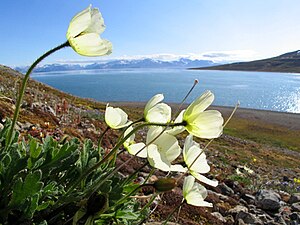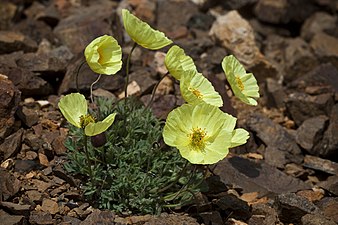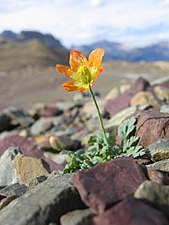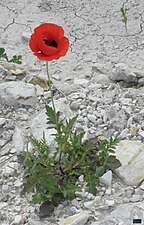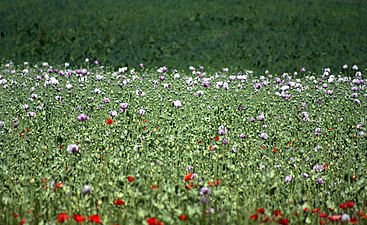Poppy
| Poppy | ||||||||||||
|---|---|---|---|---|---|---|---|---|---|---|---|---|

Opium poppy ( Papaver somniferum ), (type species), illustration |
||||||||||||
| Systematics | ||||||||||||
|
||||||||||||
| Scientific name | ||||||||||||
| Papaver | ||||||||||||
| L. |
Poppy ( Papaver ) is a genus of plants from the poppy family (Papaveraceae) with around 100 species worldwide, mainly found in the moderate latitudes of the northern hemisphere. Only one species occurs in the southern hemisphere in South Africa. There are annual species such as corn poppy ('Papaver rhoeas'), sand poppy (Papaver argemone) and opium poppy (Papaver somniferum), but also perennial species such as Turkish poppy (Papaver orientale) and medicinal poppy (Papaver bracteatum). Some types of poppy are important because of the active ingredients they contain. Opium poppies and papaver setigerum are grown for the production of opium. The alkaloid thebaine contained in medicinal poppy seeds is the starting material for the production of opioids . The oily, pleasant and nutty-scented seeds of the opium poppy are used as food, especially for desserts and pastries. The bright red flowers of the poppy, which is widespread in Central Europe, bloom from the end of May and mark the beginning of early summer (see phenology ).
description
Vegetative characteristics
Poppy species are annual, biennial, perennial (rarely monocarpic ) or perennial herbaceous plants . The parts of the plant have a white or yellow milky sap that contains poisonous alkaloids . The ascending to upright stems are usually hairy with bristles, rarely bare, branched or unbranched and can be leafy or not.
The alternate, spirally or distributed on the stem arranged in a basal rosette leaves are sessile stalked up. The leaf blade can be divided or simple. The leaf margins are seldom bare, usually indented or serrate. Stipules are missing.
Generative characteristics


The flowers are usually solitary or rarely in racemose zymous inflorescences . If inflorescence stems are present, they are usually hairy with bristles. Usually the egg-shaped to spherical flower buds are drooping before they open and the petals are in a "wrinkled" bud position. The hermaphrodite flowers are radially symmetrical with a double flower envelope . The two (rarely three) free, mostly bristly haired sepals fall off when the flower opens. The color of the four (rarely five or six) petals varies depending on the species from mostly red, orange-red to yellow, rarely white or lavender. The many (50 to 100) free, fertile stamens are formed centripetally. The stamens are white, yellow, green, purple to red or sometimes blackish. The anthers are elongated to spherical. Four to 24 carpels are a top permanent, unilocular ovary deformed, the hairy bristly or bare and is generally egg-shaped. There are many ovules . There are as many scars as carpels. These sit directly on the ovary and form a "scar disc"; There are no styluses . The edges of the disc are indented or divided. Pollination occurs by insects ( entomophilia ).
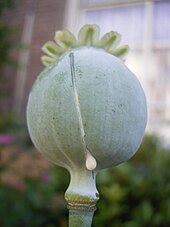

There are bristly hairy or bald, rarely prickly, hard, open or closed capsule fruits that contain many seeds. These are so-called pore capsules , a form of capsule fruit that is common in only a few plant species . These serve for a semachore spreading: If the stem tilts - some species support this by drying the stem with a kink - by wind or contact, the seeds fall out of the pores like from a salt shaker. The oil-containing seeds (formerly called Magsamen ) are black, brown, dark gray or white, small and kidney-shaped. The basic chromosome number is x = 7.
Systematics and distribution (selection)
The first publication of the generic name Papaver was made in 1753 by Carl Linnaeus in Species Plantarum , 1, p 508. As lectotype was in 1913 by NL Britton and A. Brown in Ill. Fl. NUS , second edition, 2, p. 136 Papaver somniferum L. laid down. The genus Papaver belongs to the tribe Papavereae in the subfamily of the Papaveroideae within the family of the Papaveraceae .
Papaver
Since Kadereit 1988, the Papaver genus has been divided into eleven sections:
- Section Argemonidium Spach (Syn .: Argemonorhoeades )
- Section Californica Kadereit
- Carinata section
- Section Horrida Elkan
- Macrantha Elkan Section
- Section Meconella Spach
- Section Meconidium
- Section Papaver
- Pilosa section
- Section Pseudopilosa Popov ex K.-F.Günther
- Section Rhoeadium Spach
There are about 50 to 120 (probably today about 80 to 100 species) Papaver species, mainly in the temperate areas of central and southern Europe and Asia, also in the New World, Oceania, Australia, in northern Africa and only one species in South Africa. Here is a selection:
- Papaver aculeatum Thunb. : It is the only South African species.
- Papaver alboroseum Hultén , East Asian-North American species with occurrence in Kamchatka , Canada and Alaska
- Alpine poppy ( Papaver alpinum L. ), a European species found in the Alpine countries , Poland , Bulgaria and Romania , occurs in at least five subspecies
- Apulian poppy ( Papaver apulum L. ), home: Apennine and Balkan peninsula, plus Crete
- Papaver arenarium M.Bieb. , Asian species found in Iran , Iraq , Turkey and the Caucasus
- Sand poppy ( Papaver argemone L. ), Eurasian species with distribution in Europe, the Mediterranean and Western Asia .
- Papaver armeniacum (L.) DC. , with occurrences in Iran, Turkey and Armenia
- Atlas poppy ( Papaver atlanticum (Ball) Coss. , Syn .: P. rupifragum subsp. Atlanticum (Ball) Maire ), with home in Morocco naturalized in Austria and Denmark
- Medicinal poppy ( Papaver bracteatum Lindl. ), Widespread in the Caucasus, Asia Minor , Iran (northwest) and Armenia, contains plenty of thebaine (starting material for the pharmaceutical synthesis of the strong pain reliever oxycodone or the opioid antagonist naloxone )
- Papaver californicum A.Gray , American species found in California
- Gray poppy ( Papaver canescens Tolm. ), Native to the high mountains of southern Siberia, Central and Central Asia
- Ladybird Poppy ( Papaver commutatum Fisch. & CAMey. ), Asian species with occurrence in Iran, Turkey, Armenia and Azerbaijan
- Papaver dahlianum Nordh. , arctic species with circumpolar distributionto the north. B. widespread on Svalbard
- Seed poppy ( Papaver dubium L. ): It is a Eurasian species with distribution all over Europe , in the Mediterranean region and in western Asia , it occurs in at least three subspecies
- Japanese poppy ( Papaver fauriei Fedde ), native to: alpine gravel slopes in northern Japan and on the Kuriles
- Papaver fugax Poir. (incl. Papaver caucasium M. Bieb. , Papaver floribundum Desf. ), homeland: eastern Turkey, the Caucasus, northern Iraq and Iran
- Tulip Poppy ( Papaver glaucum Boiss. & Hausskn. ), A North Asian species
- Papaver gorodkovii Tolm. & Petrovsky : It occurs at altitudes between 0 and 100 meters in Alaska and Siberia.
- Papaver humile Fedde , found in Egypt , Israel and Jordan
- Bastard poppy ( Papaver hybridum L. ), a Eurasian species with distribution in Great Britain , Hungary , Ukraine , Albania , Bulgaria, the Mediterranean area and western Asia.
- Papaver lapeyrousianum Gutermann ex Greuter & Burdet , occurs only in Spain and France (Pyrenees)
- Papaver lapponicum (Tolm.) Nordh. : An arctic species with northern circumpolar distribution.
- Brick-red poppy ( Papaver lateritium K. Koch ), native to the Caucasus and Armenia, is naturalized in Great Britain
- Papaver macounii Greene : Found in North America and Russia.
- Papaver macrostomum Boiss. & A.Huet , an Asian species found in Afghanistan , Iran, Iraq, Armenia, Georgia , Pakistan and Turkey.
- Papaver mcconnellii Hultén : It occurs in northern North America at altitudes between 1000 and 1500 meters.
- Kuril poppy ( Papaver miyabeanum Tatew. Ex Miyabe & Tatew .; Is also used as a synonym for P. nudicaule ), home: Kuril Islands
- Papaver monanthum Trautv. , an Asian species found in Armenia, Azerbaijan and Georgia
- Icelandic poppy ( Papaver nudicaule L. ) is found in the Altai Mountains, eastern Siberia , Kazakhstan , Mongolia , northwest Canada and Alaska
- Papaver oreophilum Rupr. , an Asian species found in Russia ( Kabardino-Balkaria , North Ossetia )
- Turkish poppy ( Papaver orientale L. ), Asian species originally found in Iran, Turkey, Armenia, Azerbaijan and Georgia, introduced to North America
- Little-leaved poppy ( Papaver paucifoliatum (Trautv.) Fedde ), homeland: Turkey, Caucasus
- Peacock Poppy ( Papaver pavoninum Fisch. & CAMey. ), An Asian species found in Afghanistan, Iran, Kazakhstan, Tajikistan , Turkmenistan , Uzbekistan and Pakistan
- Papaver persicum Lindl. , an Asian species found in Iran, Iraq, Turkey, Armenia and Azerbaijan, easyto confusewith Papaver fugax .
- Hairy poppy seeds ( Papaver pilosum Sibth. & Sm. ), Home: north-west Turkey
- Papaver pseudocanescens Popov , an Asian species found in Russia ( Altai , Tuva ) and Mongolia
- False Orient Poppy ( Papaver pseudo-orientale (Fedde) Medw. ), An Asian species found in Iran, Turkey, Armenia and Georgia
- Arctic poppy ( Papaver radicatum Rottb. ), A species that is northern circumpolar and common in the United States ; it is divided into at least eight subspecies
- Papaver pygmaeum Rydb. : It occurs at altitudes of 2900 meters in North America.
- Polar poppy ( Papaver radicatum Rottb. ), Home: subarctic Europe and subarctic Siberia
- Corn poppy ( Papaver rhoeas L. ), a Eurasian species found throughout Europe, western Asia and the Mediterranean
- Papaver rubroaurantiacum (fish. Ex DC.) Fish. ex Steud. , an Asian species found in Russia ( Buryatia , Chita ) and Mongolia
- Spanish poppy or rock poppy ( Papaver rupifragum Boiss. & Reut. ), Native to: Shady limestone crevices in southern Spain and Morocco
- Opium poppy , blue poppy ( Papaver somniferum L. ), an old cultivated plant. The seeds of this type are also used for desserts and cakes (coarsely ground then poppy seeds ). It is also used to obtain morphine , which is either used in medicine as an analgesic or converted into codeine by methylation to suppress the cough . Morphine is also used as a starting material for the manufacture of heroin (diacetylmorphine).
- Papaver spicatum Boiss. & Balansa , with occurrence in Turkey
- Anatolian poppy ( Papaver triniifolium Boiss. ), Found in eastern Turkey and northwestern Iran.
- Papaver umbonatum Boiss. , a West Asian species found in Israel, Jordan, Lebanon and Syria
- Papaver walpolei A.E.Porsild : This species occurs in northern North America and in Siberia.
Medicinal Poppy ( Papaver bracteatum )
Bastard poppy ( Papaver hybridum )
Habit of Papaver lapeyrousianum
Brick red poppy ( Papaver lateritium )
Turkish poppy ( Papaver orientale )
Polar poppy ( Papaver radicatum )
Not papaver
- California poppy ( Eschscholzia californica Cham. ), A North American species found in the United States and Mexico
- Horn poppy species ( Glaucium Mill. )
- Mexican tulip poppy ( Hunnemannia fumariifolia Sweet ), a Mexican species.
- Japanese forest poppy ( Hylomecon japonica (Thunb.) Prantl ), an Asian species with distribution in China , Japan and Korea
- Feather poppy ( Macleaya cordata (Willd.) R.Br. , Syn. Bocconia cordata Willd. ), An Asian species with distribution in China, Taiwan and Japan
- Asiatic spotted poppy ( Roemeria refracta DC. ), An Asiatic species with distribution in Afghanistan, Iran, Armenia, Azerbaijan, Russia ( Dagestan ), Kazakhstan, Tajikistan, Turkmenistan, Uzbekistan and China ( Xinjiang )
- Mock poppy ( Meconopsis Vig. ): With around 54 species almost only in the Sino-Himalaya region.
opiate
Opium poppy seeds themselves do not contain any opiates, but depending on the harvesting method, residues of the opiate milky sap of the seed capsules can stick to them. The consumption of food containing poppy seeds was therefore prohibited in German prisons, as this can lead to positive results in urine tests for opiates and it is not possible to distinguish whether the alkaloids were ingested through the consumption of drugs or the consumption of the named foods.
In Germany only two varieties ('Zeno morphex' and 'Mieszko') with a very low morphine content are permitted for cultivation. In Austria, the cultivation of opium poppies is completely legal and can look back on centuries of tradition. Well known is the Waldviertel gray and blue poppy, which can be found in many recipes of Austrian pastry cuisine, but also on countless shelves of grocery stores. Today, however, there is also an increasing number of poppy seeds from other countries on the market, the morphine content of which can be greatly increased due to unclean harvesting methods that leave residual amounts of opium. For this reason, poppy seeds should not be used in baby food. In the case of poppy seed cakes and poppy seed rolls, the opiates can be rendered ineffective by heating them in the oven.
symbolism
Poppy is considered the national flower of the Republic of Poland . Among other things, the 'Mieszko' variety is named after the Polish prince Mieszko I of the same name from the 10th century.
In the collective memory of the British, the poppy is associated with the four battles of Flanders during the First World War . He decorates the two national tombs of the unknown soldier in the form of artificial images . A 19-year-old man was arrested in the United Kingdom on November 11, 2012 for showing burning poppies on the Internet. In another case, a man who publicly burned plastic replicas of poppy seeds was fined.
In the Mysteries of Eleusis , the poppy was used as a symbol of the earth, of sleeping and of oblivion in honor of the goddess Demeter .
literature
- Mingli Zhang & Christopher Gray-Wilson: Papaver in der Flora of China , Volume 7, 2008, p. 278. (Section description)
- JC Carolan, IL Hook, MW Chase, JW Kadereit & TR Hodkinson: Phylogenetics of Papaver and Related Genera Based on DNA Sequences from ITS Nuclear Ribosomal DNA and Plastid trnL Intron and trnL – F Intergenic Spacers . In: Annals of Botany , Volume 98, Issue 1, pp. 141-155.
- Description in the Western Australian Flora . (English)
- Entry in the Flora of Pakistan . (English)
- Robert W. Kiger & David F. Murray: Papaver in the Flora of North America , Volume 3, 1997. (Section Description)
- Walter Erhardt among others: The big pikeperch. Encyclopedia of Plant Names . Volume 2. Verlag Eugen Ulmer, Stuttgart 2008. ISBN 978-3-8001-5406-7
- Eckehart J. Jäger, Friedrich Ebel, Peter Hanelt, Gerd K. Müller: Excursion flora from Germany . Volume 5. Herbaceous ornamental and useful plants. Spectrum Academic Publishing House. Berlin, Heidelberg 2008. ISBN 978-3-8274-0918-8
- Walter Hartmann: The poppy, its culture, history and geographical distribution, as well as the type and extent of opium consumption. Jena 1915.
- Peter Goldblatt : Biosystematic studies in papaver section oxytona. Annals of the Missouri Botanical Garden, 61 (1974), pp. 264-296.
Web links
- Guide values for morphine in poppy seeds (PDF; 300 kB) from the Federal Institute for Risk Assessment. (PDF file; 293 kB)
- Species descriptions at Mohn.tk
Individual evidence
- ^ A b Mingli Zhang & Christopher Gray-Wilson: Papaver in der Flora of China , Volume 7, 2008, p. 278: Online.
- ↑ a b Entry in the Flora of Pakistan .
- ↑ a b c Entry in the Flora of North America .
- ^ William Turner: The names of herbes (AD 1548) , ed. by James Britten, London 1881, reprint Vaduz 1965, p. 59.
- ↑ First publication scanned at biodiversitylibrary.org. .
- ↑ a b c Entry in GRIN (Germplasm Resources Information Network). Accessed November 2010.
- ↑ JW Kadereit. Sectional affinities and geographical distribution in the genus Papaver L. (Papaveraceae) , In: Contributions to the biology of plants , 1988, 63, pp. 139-156.
- ↑ a b Jaakko Jalas, Juha Suominen: Atlas florae europaeae . Volume 9 (Paeoniaceae to Capparaceae). Page 41, Helsinki 1991. ISBN 951-9108-08-4 .
- ↑ Jaakko Jalas, Juha Suominen: Atlas florae europaeae . Volume 9 (Paeoniaceae to Capparaceae). Page 49, Helsinki 1991. ISBN 951-9108-08-4
- ↑ Jaakko Jalas, Juha Suominen: Atlas Florae Europaeae . Volume 9, pages 49-53, Helsinki 1991
- ↑ 123recht: [1] . August 28, 2003.
- ^ Zeno projects: [2] . Accessed January 18, 2008.
- ↑ Blue poppy (Papaver somniferum). ( Memento from November 15, 2008 in the Internet Archive ) In: DSV Deutsche Saatveredelung. Accessed January 18, 2008.
- ↑ Waldviertler gray poppy seeds (German).
- ↑ Morphine in poppy seed and poppy seed cake - a risk for the consumer? (No longer available online.) Archived from the original on August 1, 2012 ; accessed in 2011 .
- ^ Man due to be interviewed in connection with Facebook posting. Man from Aylesham arrested. ( Memento of March 8, 2013 in the Internet Archive )
- ↑ Kent man arrested after picture of burning poppy posted on internet. In: The Guardian. 2012.
- ↑ Udo Becker: Lexicon of symbols . Nikol Verlag (licensed by Herder Verlag ), Hamburg 2012, ISBN 978-3-86820-139-0 , p. 193 .



